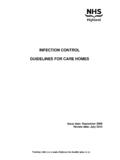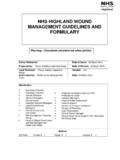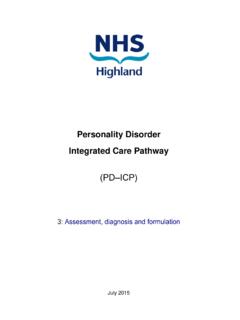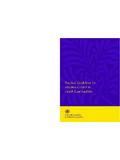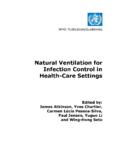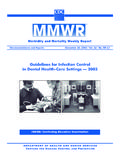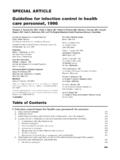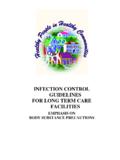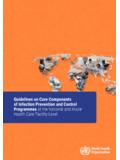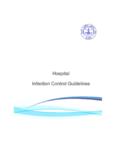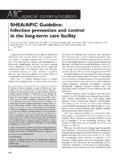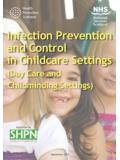Transcription of INFECTION CONTROL GUIDELINES FOR CARE …
1 Working with you to make Highland the healthy place to be INFECTION CONTROL GUIDELINES FOR care HOMES Issue date: September 2008 Review date: July 2010 Working with you to make Highland the healthy place to be 1 CONTENTS Preface .. 3 1. Introduction .. 4 Why INFECTION CONTROL is important .. 4 Who is there to help? .. 4 2. The Chain of INFECTION .. 6 3. Standard INFECTION CONTROL Precautions .. 8 What are standard INFECTION CONTROL precautions (SICPs) .. 8 Transmission based 4. Hand Hygiene .. 9 What are your hands carrying .. 9 When should you decontaminate hands? .. 9 Routine hand hygiene .. 10 Protection of broken 11 5. Protective 13 Gloves .. 13 Aprons .. 17 Face mouth/eye 17 6. Prevention of Occupational Exposure .. 18 Skin 18 Blood borne viruses and 18 Hepatitis B 20 Other immunisations.
2 20 Protection against tuberculosis .. 21 7. Management of Blood and Other Body Fluid 22 Equipment required for dealing with a spillage of 22 Spillage of Pus, Faeces or Vomit ..23 Spillage of Urine .. 23 8. Cleanliness of care Equipment .. 24 Cleaning .. 24 Single use and reuse 24 Disinfection .. 25 Sterilisation .. 26 9. Cleanliness of the Environment .. 29 29 Colour 30 10. Safe Handling of 31 What is needed? .. 31 How should linen be handled? .. 31 How should linen and clothing be washed?.. 32 Risks to 32 Storage of Linen .. 32 Staff uniforms/clothing .. 33 Working with you to make Highland the healthy place to be 2 11. Safe Handling of 34 Risk 34 Sanpro 35 Bag 36 Storage .. 36 Pharmaceutical waste .. 36 12. Patient 38 13. Collection of Specimens .. 39 14. Food 40 15. Outbreaks General .. 42 16. Viral 43 43 43 Cleaning during an outbreak.
3 43 17. MRSA .. 46 18. Clostridium difficile .. 49 19. Immunisation of Residents .. 52 20. care of Urinary Catheters .. 53 21. Enteral Feeding .. 54 22. Last 55 23. Education Resources .. 56 Education for the INFECTION CONTROL key worker .. 56 Hand 56 Induction 56 24. Pandemic Influenza .. 58 Pandemic flu what is it? .. 58 How is flu transmitted?.. 58 What can be done to prepare?.. 58 Appendix 1 Sharps Inoculation Injury Reporting Form .. 60 Appendix 2 Stool Record Chart .. 61 Bibliography .. 63 Information Leaflets - Norovirus - MRSA - Clostridium difficile Working with you to make Highland the healthy place to be 3 PREFACE Protection of residents from INFECTION is an important part of high quality care , and it also contributes to the safety of the environment for staff and visitors. The Regulation of care (Scotland) Act 2001 requires care service providers to have appropriate procedures for the CONTROL of INFECTION , and in March 2005 INFECTION CONTROL in Adult care Homes: Final Standards was published by the Scottish Executive in order to clarify what constitutes best practice in INFECTION CONTROL in this setting.
4 This guidance should be read in conjunction with the Standards. Each of the Standards in the Scottish Executive document is accompanied by a helpful audit tool. Managers should make full use of the audit tools to ensure that the home complies with best practice. If you need advice or clarification concerning the implementation of any of the Standards, please contact the Health Protection Team at NHS Highland. Working with you to make Highland the healthy place to be 4 1. INTRODUCTION Why INFECTION CONTROL is important Many infections have the potential to spread in a care home, due to the sharing of eating and living accommodation, and the fact that residents may have an increased susceptibility to INFECTION due to various factors: Age Immune status Poor nutrition Underlying medical conditions such as cancer, diabetes, heart problems Antibiotic therapy Incontinence Indwelling medical devices such as urinary catheters or gastric feeding tubes Breaks in the skin INFECTION CONTROL has also become more important due to the increasing numbers of organisms that have become resistant to treatment such as meticillin resistant Staphylococcus aureus (MRSA), Clostridium difficile, the emergence of relatively new organisms such as O157, and the potential for the spread of blood borne viruses.
5 Healthcare-associated infections may worsen underlying medical conditions and lead to avoidable admission to hospital, and may occasionally be life-threatening. Prevention of INFECTION is everyone s business! Who is there to help? The Health Protection Team of NHS Highland is based within the Public Health Department at Assynt House, Beechwood Park, Inverness. See below for contact details. Advice and guidance is available from the Consultant in Public Health Medicine (Health Protection) who has responsibility for the prevention, surveillance, investigation and CONTROL of communicable disease in the Highlands, and the Health Protection Nurse Specialists. Advice and guidance can be given on all matters relating to INFECTION CONTROL , including disinfection, laundry, waste management, and individual client management. You may also have concern when individuals, either clients or staff, suffer from specific infectious diseases.
6 The following list gives some examples of infections , the occurrence of which may mean you wish to consult the Health Protection Team: Blood borne viruses (HIV, Hepatitis) Campylobacter Clostridium difficile O157 Working with you to make Highland the healthy place to be 5 Influenza Legionnaires disease Lice MRSA Salmonella Scabies ( in either residents or staff) Streptococcal infections Tuberculosis Varicella zoster (shingles or chicken pox) Contact details: Consultant in Public Health Medicine ((Health Protection): Dr Ken Oates Health Protection Nurse Specialists: Helen Tissington Lorraine McKee Tel: 01463 704886 Environmental Health Your local Environmental Health office can provide information and advice on food safety. They can be contacted through your local Council Service Point or by emailing if you are in Highland Council Area, or if you are in Argyll & Bute. Other sources of information NHS Highland provides a range of guidance about communicable disease which can be accessed at: Follow the links All Services A-Z/Health Protection Team.)
7 You will find leaflets about various gastro-intestinal diseases, and also GUIDELINES for the Management of Scabies. Working with you to make Highland the healthy place to be 6 2. THE CHAIN OF INFECTION In order for INFECTION to occur several things have to happen. This is often referred to as the Chain of INFECTION . The six links in the chain are: Infectious Agent or the microorganism which has the ability to cause disease The Reservoir or source of INFECTION where the microorganism can thrive. This may be a person, an animal, any object in the general environment, food or water. The Portal of Exit from the reservoir. This describes the way the microorganism leaves the reservoir. For example, in the case of a person with flu, this would include coughing and sneezing. In the case of someone with gastro-enteritis microorganisms would be transmitted in the faeces. The Mode of Transmission.
8 This describes how microorganisms are transmitted from one person or place to another. This could be via someone s hands, on an object, or through the air. The Portal of Entry. This is how the INFECTION enters another individual. This could be landing on a mucous membrane, being breathed in, entering via a wound, or a tube such as a catheter. The Susceptible Host. This describes the person who is vulnerable to INFECTION . infections can be prevented by breaking the Chain of INFECTION . The following page illustrates the Chain, and gives examples of actions that can be taken to break it. The overall aim of Standard INFECTION CONTROL Precautions is to break the Chain. Working with you to make Highland the healthy place to be 7 Treatment of underlying diseases Flu & pneumococcal immunisation THE CHAIN OF INFECTION & HOW TO BREAK IT Recognition & protection of high-risk patients Aseptic Technique Catheter care Wound care Hand Hygiene Disinfection & sterilisation Safe food handling Ensure staff are healthy & immunised Thorough cleaning of the environment & equipment Disinfection & sterilisation INFECTIOUS AGENT Bacteri, fungi, viruses & protozoa RESERVOIRS People, equipment, food & water PORTAL OF EXIT Excretions, secretions, skin scales MEANS OF TRASMISSION Direct contact, objects, contaminated food, air SUSCEPTIBLE HOST Underlying illness, surgery PORTAL OF ENTRY Mucous membranes, broken skin etc Use of PPE Hand hygiene Safe handling of blood & body fluids, cough etiquette etc Isolation when appropriate Safe handling and disposal of waste Rapid.
9 Accurate identification of organisms Working with you to make Highland the healthy place to be 8 3. STANDARD INFECTION CONTROL PRECAUTIONS What are Standard INFECTION CONTROL Precautions (SICPs)? SICPs are core measures that should be used at all times, in all care settings, by all carers. They are based upon the assumption that every individual could be carrying potentially harmful microorganisms and that there is the potential for transmission. There are nine elements: Hand hygiene Use of personal protective equipment Prevention of occupational exposure Management of blood and body fluid spillage Cleanliness of care equipment Cleanliness of the environment Safe handling of linen Safe handling of waste Patient placement In all situations you must assess the risk of the task that you are doing, and not the risk of the patient. Transmission Based Precautions In some situations it may be necessary to use additional INFECTION CONTROL precautions know as Transmission Based Precautions.
10 Appropriate advice can be obtained from the Health Protection Team. Working with you to make Highland the healthy place to be 9 4. HAND HYGIENE What are your hands carrying? In any care setting, hand hygiene is the most important activity for preventing the spread of INFECTION from one person to another. Microorganisms found on hands may be categorised as either resident or transient . Resident organisms live within the epidermis (for example in hair follicles and sweat glands) and they protect the skin from invasion by more harmful micro-organisms. They are not easily removed. Transient organisms are found on the surface of the skin, and they are transferred by direct contact with other people, equipment or other body sites. As their name implies, who and what a person touches in the course of the day will determine which micro-organisms are on their hands. There are certainly lots of opportunities to pick up micro-organisms.
